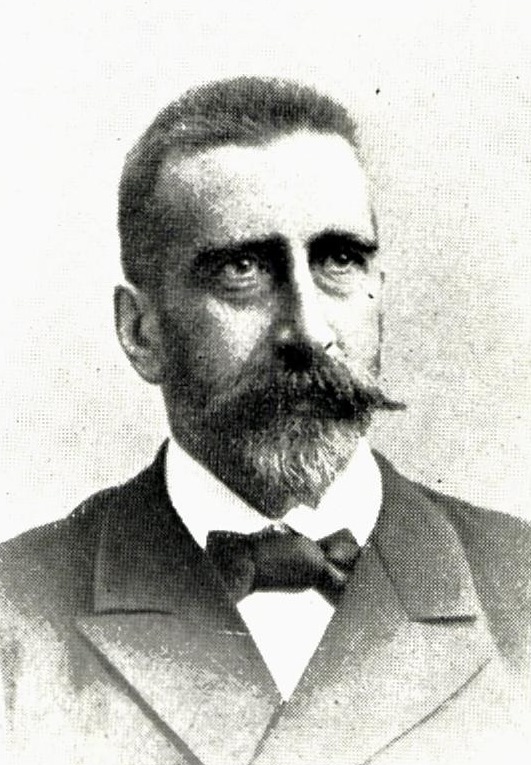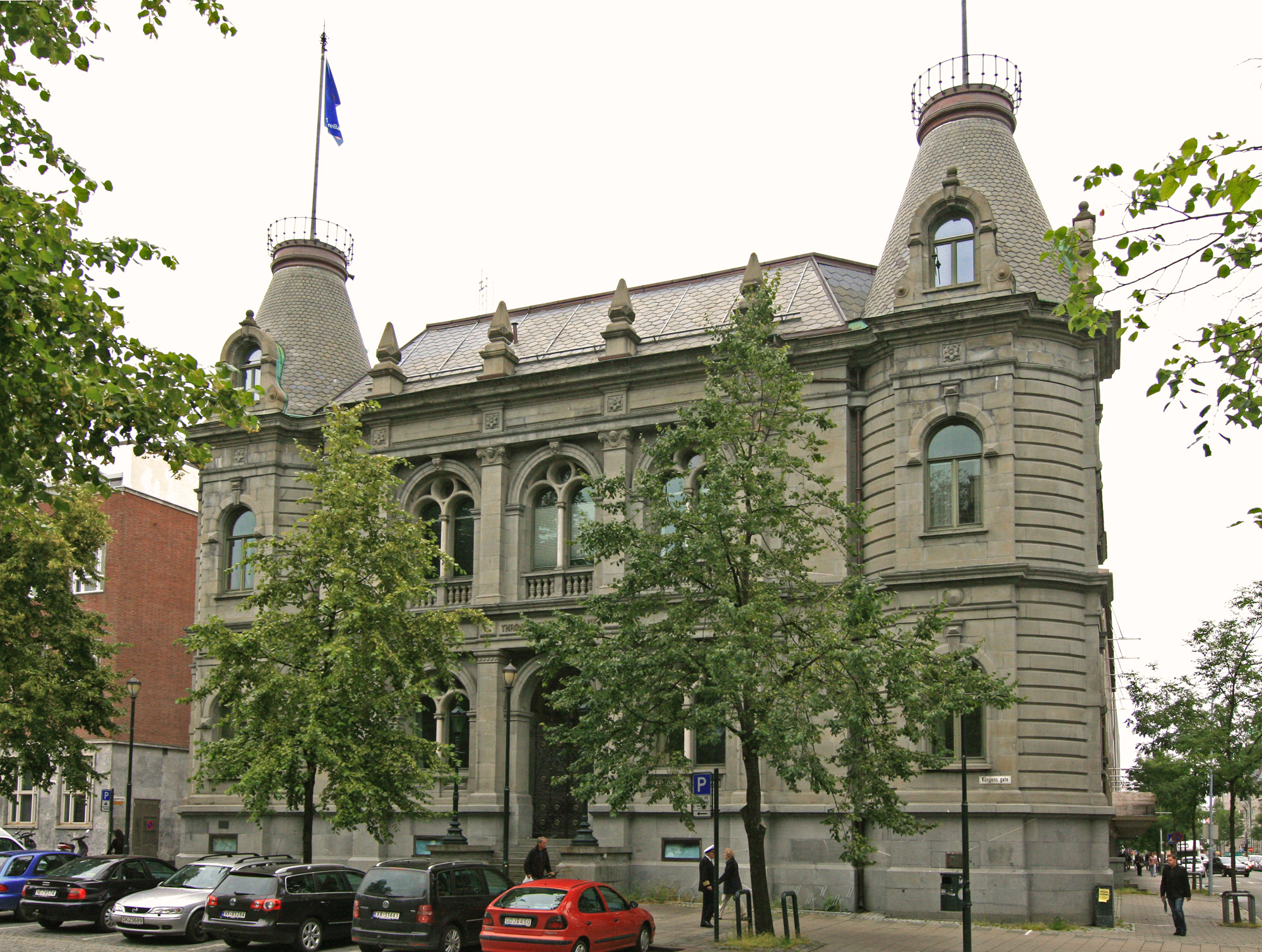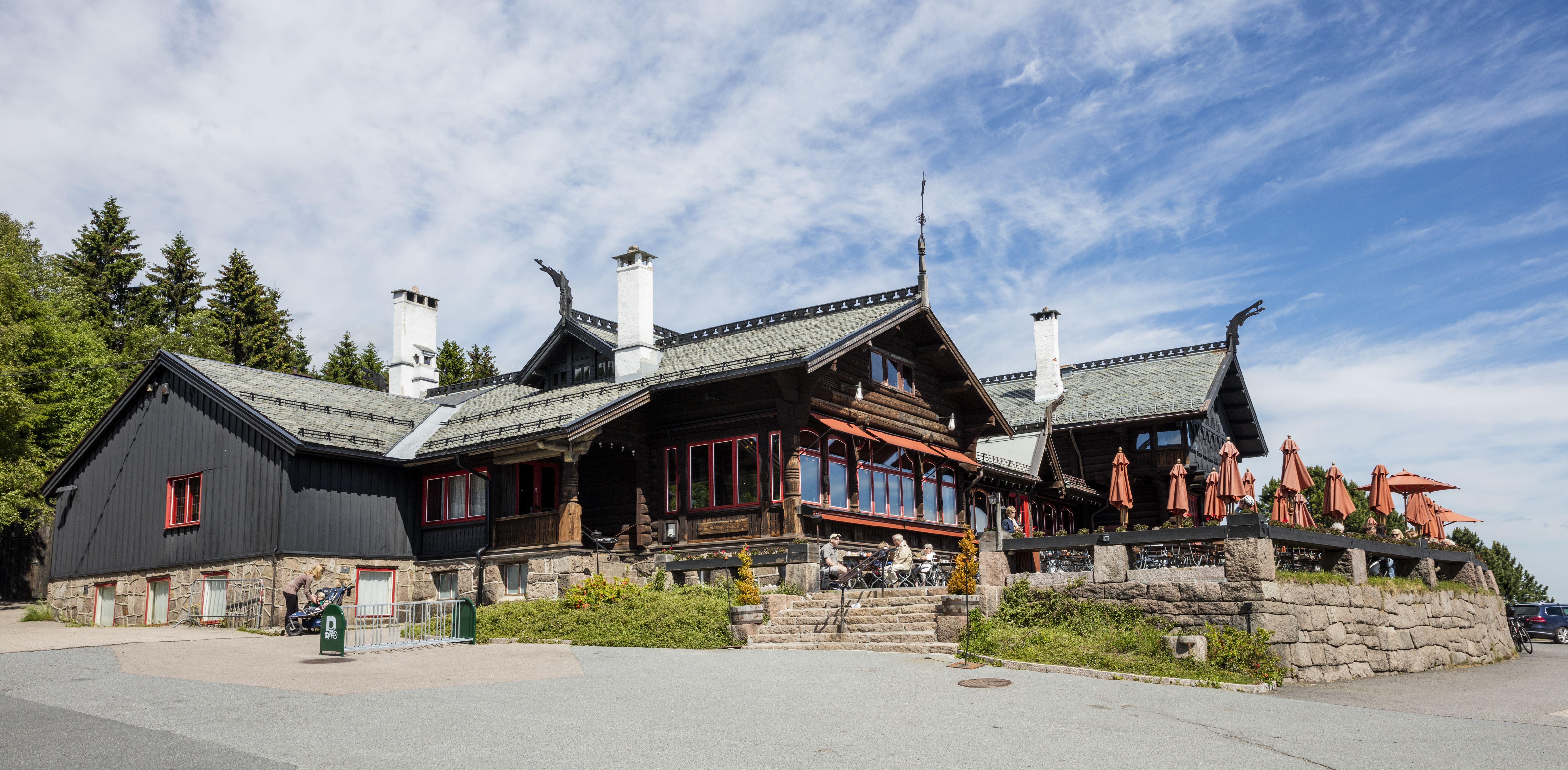|
Adolf Schirmer
Adolf Schirmer (1 October 1850 – 11 August 1930) was a Norwegian architect. Personal life Adolf Schirmer was born in Christiania (now Oslo), Norway. He was the son of architect Heinrich Ernst Schirmer and Sophie Ottilia Major (1821–1861). He was a brother of Herman Major Schirmer and nephew of Herman Wedel Major. In November 1878 in Braunschweig he married Hildur Koch (1856–1914). He died in August 1930 in Bærum. Career His initial training was with his father's practice and at the Royal School of Drawing under sculptor Julius Middelthun. He stayed a short period in Germany in 1870, before being employed by Georg Andreas Bull in Christiania from 1871 to 1872. He then took lessons at the Bauakademie in Berlin and École des Beaux-Arts in Paris, graduating in 1874. Schirmer ran his own company in Christiania until 1886. In 1887, he was appointed the state's building inspector with responsibility for the state-owned properties. He has designed several public buildings, h ... [...More Info...] [...Related Items...] OR: [Wikipedia] [Google] [Baidu] |
Adolf Schirmer
Adolf Schirmer (1 October 1850 – 11 August 1930) was a Norwegian architect. Personal life Adolf Schirmer was born in Christiania (now Oslo), Norway. He was the son of architect Heinrich Ernst Schirmer and Sophie Ottilia Major (1821–1861). He was a brother of Herman Major Schirmer and nephew of Herman Wedel Major. In November 1878 in Braunschweig he married Hildur Koch (1856–1914). He died in August 1930 in Bærum. Career His initial training was with his father's practice and at the Royal School of Drawing under sculptor Julius Middelthun. He stayed a short period in Germany in 1870, before being employed by Georg Andreas Bull in Christiania from 1871 to 1872. He then took lessons at the Bauakademie in Berlin and École des Beaux-Arts in Paris, graduating in 1874. Schirmer ran his own company in Christiania until 1886. In 1887, he was appointed the state's building inspector with responsibility for the state-owned properties. He has designed several public buildings, h ... [...More Info...] [...Related Items...] OR: [Wikipedia] [Google] [Baidu] |
Heinrich Ernst Schirmer
Heinrich Ernst Schirmer (27 August 1814 – 6 December 1887) was a German-born architect most noted for his work in Norway. Schirmer worked in Norway from 1838 to 1883 and left his mark on a number of public buildings. He contributed significantly to the introduction of the so-called Swiss architectural style in Norway, based partly on Italian villa style, Gothic Revival, and neoclassicism. Biography Schirmer was born in Leipzig, Germany. He was the son of Johan Gottlieb Schirmer and Johanne Sophie Kühne. He was the father of architect Adolf Schirmer. He received his architectural education at art academies in Dresden from 1831 to 1834, and in Munich from 1834 to 1837. In Munich he was influenced by German neoclassicist architect Leo von Klenze and his nation-building and urban design ideas. Schirmer was construction manager for the rebuilding of the Oslo Cathedral between 1849 and 1850. In 1853 he entered into a partnership with fellow German-born architect Wilhelm von Hanno. ... [...More Info...] [...Related Items...] OR: [Wikipedia] [Google] [Baidu] |
Statsbygg
The Norwegian Directorate of Public Construction and Property ( no, Statsbygg) is a Norwegian government agency that manages central parts of the real estate portfolio of the Government of Norway. Operation The Norwegian Directorate of Public Construction and Property provides construction and property management services on behalf of the Norwegian Government. This includes 2.7 million square meters in 2,350 buildings, of which 115 are located abroad. The portfolio includes office buildings, heritage sites, campuses, operational facilities, and other buildings. The directorate also manages the Global Seed Vault in Svalbard. The agency has at any time about 200 construction projects under way, completing about 10 to 20 new structures each year. The directorate has 860 employees. The head office is situated on Bishop Gunnerus Street (''Biskop Gunnerus' gate'') in Oslo. There are regional offices in Porsgrunn, Bergen, Trondheim, and Tromsø. Some parts of the public real estate are ... [...More Info...] [...Related Items...] OR: [Wikipedia] [Google] [Baidu] |
1930 Deaths
Year 193 ( CXCIII) was a common year starting on Monday (link will display the full calendar) of the Julian calendar. At the time, it was known as the Year of the Consulship of Sosius and Ericius (or, less frequently, year 946 ''Ab urbe condita''). The denomination 193 for this year has been used since the early medieval period, when the Anno Domini calendar era became the prevalent method in Europe for naming years. Events By place Roman Empire * January 1 – Year of the Five Emperors: The Roman Senate chooses Publius Helvius Pertinax, against his will, to succeed the late Commodus as Emperor. Pertinax is forced to reorganize the handling of finances, which were wrecked under Commodus, to reestablish discipline in the Roman army, and to suspend the food programs established by Trajan, provoking the ire of the Praetorian Guard. * March 28 – Pertinax is assassinated by members of the Praetorian Guard, who storm the imperial palace. The Empire is auctioned of ... [...More Info...] [...Related Items...] OR: [Wikipedia] [Google] [Baidu] |
1850 Births
Year 185 ( CLXXXV) was a common year starting on Friday (link will display the full calendar) of the Julian calendar. At the time, it was known as the Year of the Consulship of Lascivius and Atilius (or, less frequently, year 938 ''Ab urbe condita''). The denomination 185 for this year has been used since the early medieval period, when the Anno Domini calendar era became the prevalent method in Europe for naming years. Events By place Roman Empire * Nobles of Britain demand that Emperor Commodus rescind all power given to Tigidius Perennis, who is eventually executed. * Publius Helvius Pertinax is made governor of Britain and quells a mutiny of the British Roman legions who wanted him to become emperor. The disgruntled usurpers go on to attempt to assassinate the governor. * Tigidius Perennis, his family and many others are executed for conspiring against Commodus. * Commodus drains Rome's treasury to put on gladiatorial spectacles and confiscates property to suppo ... [...More Info...] [...Related Items...] OR: [Wikipedia] [Google] [Baidu] |
Order Of St
Order, ORDER or Orders may refer to: * Categorization, the process in which ideas and objects are recognized, differentiated, and understood * Heterarchy, a system of organization wherein the elements have the potential to be ranked a number of different ways * Hierarchy, an arrangement of items that are represented as being "above", "below", or "at the same level as" one another * an action or inaction that must be obeyed, mandated by someone in authority People * Orders (surname) Arts, entertainment, and media * ''Order'' (album), a 2009 album by Maroon * "Order", a 2016 song from ''Brand New Maid'' by Band-Maid * ''Orders'' (1974 film), a 1974 film by Michel Brault * ''Orders'', a 2010 film by Brian Christopher * ''Orders'', a 2017 film by Eric Marsh and Andrew Stasiulis * ''Jed & Order'', a 2022 film by Jedman Business * Blanket order, purchase order to allow multiple delivery dates over a period of time * Money order or postal order, a financial instrument usually intend ... [...More Info...] [...Related Items...] OR: [Wikipedia] [Google] [Baidu] |
Order Of The Dannebrog
The Order of the Dannebrog ( da, Dannebrogordenen) is a Danish order of chivalry instituted in 1671 by Christian V. Until 1808, membership in the order was limited to fifty members of noble or royal rank, who formed a single class known as ''White Knights'' to distinguish them from the ''Blue Knights'' who were members of the Order of the Elephant. In 1808, the Order was reformed and divided into four classes. The ''Grand Commander'' class is reserved to persons of princely origin. It is awarded only to royalty with close family ties with the Danish Royal House. The statute of the Order was amended in 1951 by a Royal Ordinance so that both men and women could be members of the Order. Today, the Order of the Dannebrog is a means of honouring and rewarding the faithful servants of the modern Danish state for meritorious civil or military service, for a particular contribution to the arts, sciences or business life, or for working for Danish interests. Insignia The ''badg ... [...More Info...] [...Related Items...] OR: [Wikipedia] [Google] [Baidu] |
Tekna (Norway)
Tekna (short for ''Teknisk-naturvitenskapelig forening'', en, Norwegian Society of Graduate Technical and Scientific Professionals) is a union for graduate technical and scientific professionals in Norway. History and profile It was established in 1874 under the name ''Den Norske Ingeniør- og Arkitektforening'' ('the Norwegian Engineer and Architect Association'). In 1912 it was reorganized as ''Den Norske Ingeniørforening'' ('the Norwegian Engineer Association'). It was again renamed to ''Norske Sivilingeniørers Forening'' ('Civil Engineers' Association of Norway') in 1973, and to Tekna in 2004. It has 97,000 members as of 2022. The headquarters are in Oslo. It publishes ''Teknisk Ukeblad ''Teknisk Ukeblad'' (''TU'', en, Technical Weekly Magazine) is a Norwegian engineering magazine. The magazine has its headquarters in Oslo, Norway. History and profile ''TU'' has appeared weekly since 13 April 1883 and was published by Ingeniørf ...'' together with NITO. Tekna is a mem ... [...More Info...] [...Related Items...] OR: [Wikipedia] [Google] [Baidu] |
National Romanticism
Romantic nationalism (also national romanticism, organic nationalism, identity nationalism) is the form of nationalism in which the state claims its political legitimacy as an organic consequence of the unity of those it governs. This includes such factors as language, race, ethnicity, culture, religion, and customs of the nation in its primal sense of those who were born within its culture. It can be applied to ethnic nationalism as well as civic nationalism. Romantic nationalism arose in reaction to dynastic or imperial hegemony, which assessed the legitimacy of the state from the top down, emanating from a monarch or other authority, which justified its existence. Such downward-radiating power might ultimately derive from a god or gods (see the divine right of kings and the Mandate of Heaven). Among the key themes of Romanticism, and its most enduring legacy, the cultural assertions of romantic nationalism have also been central in post-Enlightenment art and political philos ... [...More Info...] [...Related Items...] OR: [Wikipedia] [Google] [Baidu] |
Frognerseteren
Frognerseteren is a neighborhood of Oslo, Norway, located within Nordmarka. It is a popular starting point for recreational hiking and skiing in Oslo. Frognerseteren Station is the terminal station of the Holmenkollen Line of the Oslo Metro. Frognerseteren Restaurant () and conference facilities is one of the best examples of architectural style Dragestil in Oslo. www.visitnorway.com ''Frognerseteren'' means the ''seter'' ("mountain dairy farm", roughly comparable to ) of Frogner (Manor). Frognerseteren with part ... [...More Info...] [...Related Items...] OR: [Wikipedia] [Google] [Baidu] |
Ullevål University Hospital
Ullevaal Stadion () is an all-seater football stadium located in Oslo, Norway. It is the home ground of the Norway national football team, and the site of the Norwegian Cup Final. From its opening in 1926 to 2009 it was the home ground of FK Lyn and from 1999 to 2017 was a home ground of Vålerenga IF. With a capacity of approximately 28,000, it is the largest football stadium in Norway. The national stadium is fully owned by the Football Association of Norway (NFF). The stadium opened on 26 September 1926 as the home ground for Lyn and several other local teams. The first international match was played in 1927, and NFF started gradually purchasing part of the stadium company. The peak attendance dates from 1935, when 35,495 people saw Norway play Sweden. Since 1948, Ullevaal has hosted the finals of the Norwegian Football Cup, and in 1967 the Japp Stand was completed. A new renovation started with the completion of the single-tier West Stand in 1985, and continued with the t ... [...More Info...] [...Related Items...] OR: [Wikipedia] [Google] [Baidu] |





